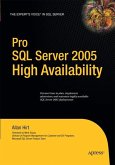The definitive guide for all network administrators on how to keep their Windows network up and running smoothly all day every day.
While high availability is a topic of increasing importance to Windows administrators, there is very little information available about it
Solutions presented are taken from real production deployments
Covers all high-availability scenarios in load balancing and clustering, with extensive coverage of monitoring, performance, and operations management
Over the last year many companies and government organizations began migrating from platforms such as UNIX to the Windows 2003 platform to have a high performance system that is available 24X7. However, these organizations face a huge learning curve on how best to set up high performance Windows Server 2003 networks for maximum availability and power. This book provides a clear and concise road map on keeping systems up 24X7 with the Windows platform. It delves into topics that explain how to use Windows Server 2003 technology for scalability, uptime, performance, and management, and how to avoid getting in trouble at the same time. This book answers questions network administrators ask such as, "Should we cluster, load balance, or both? Or should we invest in hot standbys? What works best?" After providing answers, Shapiro goes beyond discussing failover and fault tolerance to explaining monitoring, disaster recovery, and choosing the right technology to achieve maximum availability and high performance. This is the first book that not only provides thorough coverage of core cluster configuration and load balancing, but also explains how to maintain and administer a Windows 2003 high performance system, and restore and recover failed servers in the event of a disaster. Product Description
Over the last year many companies and government organizations beganmigrating from platforms such as UNIX to the Windows 2003 platform tohave a high performance system that is available 24X7. However, theseorganizations face a huge learning curve on how best to set up highperformance Windows Server 2003 networks for maximum availability andpower. This book provides a clear and concise road map on keeping systemsup 24X7 with the Windows platform. It delves into topics that explain how touse Windows Server 2003 technology for scalability, uptime, performance, andmanagement, and how to avoid getting in trouble at the same time. This bookanswers questions network administrators ask such as, Should we cluster, loadbalance, or both? Or should we invest in hot standbys? What works best?After providing answers, Shapiro goes beyond discussing failover and faulttolerance to explaining monitoring, disaster recovery, and choosing the righttechnology to achieve maximum availability and high performance. This is thefirst book that not only provides thorough coverage of core clusterconfiguration and load balancing, but also explains how to maintain andadminister a Windows 2003 high performance system, and restore and recoverfailed servers in the event of a disaster.
Features + Benefits
The definitive guide for all network administrators on how to keep their Windows network up and running smoothly all day every day.
° While high availability is a topic of increasing importance to Windows administrators, there is very little information available about it
° Solutions presented are taken from real production deployments
° Covers all high-availability scenarios in load balancing and clustering, with extensive coverage of monitoring, performance, and operations management
Backcover
This is the definitive resource for every network administrator, consultant, and architect who needs to maximize availability, scalability, and performance in Windows server environments.
Drawing on two decades of Windows server experience, Jeffrey Shapiro and Marcin Policht have written the most realistic, comprehensive, and independent Windows high availability guide ever published. One step at, a time, they help you plan, implement, and manage clustering, load balancing, fault tolerance, SQL Server, Exchange Server, and much more. Along the way, they address crucial high availability topics that are virtually ignored by most books, such as disaster recovery, performance monitoring, and operations management.
Shapiro and Policht offer a clear, concise roadmap for keeping Windows servers running 24x7 and delivering on even the most challenging service-level agreements. They provide real-world case studies and easy-to-use instructions designed to help readers make better decisions more rapidly.
Coverage includes
Building the foundations for a highly available Active Directory and network architecture
Selecting and integrating high-performance hardware, storage, and networks
Installing and configuring Windows Clustering Services for both scale-out and failover
Leveraging the Microsoft Operations Framework (MOF) and Microsoft Systems Architecture (MSA)
Delivering high-performance, high availability file- and print-server solutions
Using clustering to maximize SQL Server and Exchange Server availability
Restoring failed servers: best practices and step-by-step techniques for recovering from downtime or disaster
Deploying Network Load Balancing (NLB) IIS and application servers
Administering Windows Server 2003 high-performance systems-including performance monitoring and alerts with Microsoft Operations Manager
Avoiding the pitfalls associated with Windows high availability solutions
© Copyright Pearson Education. All rights reserved.
Acknowledgments.
About the Authors.
Preface.
I. HIGH-PERFORMANCE WINDOWS COMPUTING.
1. The World of High-Performance, High vailability Windows Computing.
Introduction.
Service Level.
Availability.
High Availability, Downtime, and Failure.
Scale-Out Availability and Windows Server 2003.
Clustering.
Scale-Up Availability.
Scale-Out or Scale-Up?
Share Everything Versus Share Nothing.
High-Performance Computing.
The Need for High-Performance Computing.
High-Performance Computing for Everyone.
Supercomputers in Every Closet.
Processing and Memory.
High-Performance Components.
Microsoft and the Cornell Theory Center.
Time-Out.
2. Choosing High-Performance Hardware.
Introduction.
Standards, Vendors, and Common Sense.
Vendors.
Common Sense.
Choosing the CPU.
Memory.
DRAM.
DRAM with EDO.
Synchronous DRAM.
Direct Rambus DRAM (RDRAM).
Time-Out.
3. Storage for Highly Available Systems.
Introduction.
Redundancy and Availability of Storage.
RAID Refresher.
RAID 1.
RAID 5.
RAID 10.
RAID Controllers.
Server Attached Storage Solutions.
Network Attached Storage Solutions (NAS).
Storage Area Networks (SAN).
IP-Based Storage Solutions.
Time-Out.
4. Highly Available Networks.
Introduction.
Backbone Design for High Availability.
Bandwidth Field Notes.
Ethernet
What to Look for in Network Interface Cards.
Hubs, Switches, and Routers.
Layer 2 Switches.
Layer 3, Layer 4, and Beyond.
Routers and Routing in High Availability Architecture.
Using Hubs for Failover Interconnects.
SAN Topology Primer.
Fibre Channel.
SAN Topology.
Ports.
Point-to-Point Topology.
FC-AL.
Fabric.
Zoning.
Architecting SAN Topology for High Availability.
Time-Out.
5. Preparing the Platform for a High-Performance Network.
Introduction.
Architecting Primer.
Create a Design Plan.
Design Goals.
Design Components.
Design Decisions.
Design Implications.
Active Directory Services, Logical Architecture.
Forest Plan for Highly Available Systems.
Single Global Catalog.
Domain Namespace.
External DNS Domain Name.
Domain Controllers (DCs).
Multi-Master Operations (Global Catalogs).
Single Master Operations (FSMO Roles).
Schema Master.
Domain Naming Master.
RID (Relative Identifier Master).
Primary Domain Controller Emulator.
Infrastructure Master.
Miscellaneous Roles for Domain Controllers.
Preferred Group Policy Administrator Domain Controller.
Time Service.
Organizational Units.
Group Policy Backgrounder.
Password Policy.
Event Log.
Group Policy Objects for Cluster Servers.
Active Directory Physical Architecture.
Subnets.
Site Links.
Cost.
Replication Schedule and Notification.
Transports.
Connection Objects.
Site Link Bridge.
Site Layout and Topology.
AD Integrated DDNS (Dynamic DNS).
DNS Architecture.
Hub Sites.
Administration of DNS Servers.
DDNS Configuration.
WINS.
Hub Sites.
Administration of WINS Servers.
DHCP (Dynamic Host Configuration Protocol).
DHCP Architecture.
DHCP Parameters.
Scope Details.
Naming Conventions.
Time-Out.
6. Building the Foundations for a Highly Available Architecture.
Introduction.
Windows Clustering 101.
The Cluster Model.
The Quorum Resource.
Deployment Scenarios.
Forest Creation Process.
Installation of Support Server.
Installation.
Installation of Root Domain.
Process.
Quality Assurance.
Forest Preparation, DNS, and Exchange.
Installation of Bridgehead Servers and the Child Domain.
Installing DHCP and WINS Services.
Patching and Updating Domain Controllers.
Exchange Domain Preparation.
Creation of Initial Service and Administration Resources.
Clustering.
Create Shared Disk Resources.
Prepare the Cluster Network.
Start Server Cl
Over the last year many companies and government organizations began
migrating from platforms such as UNIX to the Windows 2003 platform to
have a high performance system that is available 24X7. However, these
organizations face a huge learning curve on how best to set up high
performance Windows Server 2003 networks for maximum availability and
power. This book provides a clear and concise road map on keeping systems
up 24X7 with the Windows platform. It delves into topics that explain how to
use Windows Server 2003 technology for scalability, uptime, performance, and
management, and how to avoid getting in trouble at the same time. This book
answers questions network administrators ask such as, Should we cluster, load
balance, or both? Or should we invest in hot standbys? What works best?
After providing answers, Shapiro goes beyond discussing failover and fault
tolerance to explaining monitoring, disaster recovery, and choosing the right
technology to achieve maximum availability and high performance. This is the
first book that not only provides thorough coverage of core cluster
configuration and load balancing, but also explains how to maintain and
administer a Windows 2003 high performance system, and restore and recover
failed servers in the event of a disaster.
Hinweis: Dieser Artikel kann nur an eine deutsche Lieferadresse ausgeliefert werden.
While high availability is a topic of increasing importance to Windows administrators, there is very little information available about it
Solutions presented are taken from real production deployments
Covers all high-availability scenarios in load balancing and clustering, with extensive coverage of monitoring, performance, and operations management
Over the last year many companies and government organizations began migrating from platforms such as UNIX to the Windows 2003 platform to have a high performance system that is available 24X7. However, these organizations face a huge learning curve on how best to set up high performance Windows Server 2003 networks for maximum availability and power. This book provides a clear and concise road map on keeping systems up 24X7 with the Windows platform. It delves into topics that explain how to use Windows Server 2003 technology for scalability, uptime, performance, and management, and how to avoid getting in trouble at the same time. This book answers questions network administrators ask such as, "Should we cluster, load balance, or both? Or should we invest in hot standbys? What works best?" After providing answers, Shapiro goes beyond discussing failover and fault tolerance to explaining monitoring, disaster recovery, and choosing the right technology to achieve maximum availability and high performance. This is the first book that not only provides thorough coverage of core cluster configuration and load balancing, but also explains how to maintain and administer a Windows 2003 high performance system, and restore and recover failed servers in the event of a disaster. Product Description
Over the last year many companies and government organizations beganmigrating from platforms such as UNIX to the Windows 2003 platform tohave a high performance system that is available 24X7. However, theseorganizations face a huge learning curve on how best to set up highperformance Windows Server 2003 networks for maximum availability andpower. This book provides a clear and concise road map on keeping systemsup 24X7 with the Windows platform. It delves into topics that explain how touse Windows Server 2003 technology for scalability, uptime, performance, andmanagement, and how to avoid getting in trouble at the same time. This bookanswers questions network administrators ask such as, Should we cluster, loadbalance, or both? Or should we invest in hot standbys? What works best?After providing answers, Shapiro goes beyond discussing failover and faulttolerance to explaining monitoring, disaster recovery, and choosing the righttechnology to achieve maximum availability and high performance. This is thefirst book that not only provides thorough coverage of core clusterconfiguration and load balancing, but also explains how to maintain andadminister a Windows 2003 high performance system, and restore and recoverfailed servers in the event of a disaster.
Features + Benefits
The definitive guide for all network administrators on how to keep their Windows network up and running smoothly all day every day.
° While high availability is a topic of increasing importance to Windows administrators, there is very little information available about it
° Solutions presented are taken from real production deployments
° Covers all high-availability scenarios in load balancing and clustering, with extensive coverage of monitoring, performance, and operations management
Backcover
This is the definitive resource for every network administrator, consultant, and architect who needs to maximize availability, scalability, and performance in Windows server environments.
Drawing on two decades of Windows server experience, Jeffrey Shapiro and Marcin Policht have written the most realistic, comprehensive, and independent Windows high availability guide ever published. One step at, a time, they help you plan, implement, and manage clustering, load balancing, fault tolerance, SQL Server, Exchange Server, and much more. Along the way, they address crucial high availability topics that are virtually ignored by most books, such as disaster recovery, performance monitoring, and operations management.
Shapiro and Policht offer a clear, concise roadmap for keeping Windows servers running 24x7 and delivering on even the most challenging service-level agreements. They provide real-world case studies and easy-to-use instructions designed to help readers make better decisions more rapidly.
Coverage includes
Building the foundations for a highly available Active Directory and network architecture
Selecting and integrating high-performance hardware, storage, and networks
Installing and configuring Windows Clustering Services for both scale-out and failover
Leveraging the Microsoft Operations Framework (MOF) and Microsoft Systems Architecture (MSA)
Delivering high-performance, high availability file- and print-server solutions
Using clustering to maximize SQL Server and Exchange Server availability
Restoring failed servers: best practices and step-by-step techniques for recovering from downtime or disaster
Deploying Network Load Balancing (NLB) IIS and application servers
Administering Windows Server 2003 high-performance systems-including performance monitoring and alerts with Microsoft Operations Manager
Avoiding the pitfalls associated with Windows high availability solutions
© Copyright Pearson Education. All rights reserved.
Acknowledgments.
About the Authors.
Preface.
I. HIGH-PERFORMANCE WINDOWS COMPUTING.
1. The World of High-Performance, High vailability Windows Computing.
Introduction.
Service Level.
Availability.
High Availability, Downtime, and Failure.
Scale-Out Availability and Windows Server 2003.
Clustering.
Scale-Up Availability.
Scale-Out or Scale-Up?
Share Everything Versus Share Nothing.
High-Performance Computing.
The Need for High-Performance Computing.
High-Performance Computing for Everyone.
Supercomputers in Every Closet.
Processing and Memory.
High-Performance Components.
Microsoft and the Cornell Theory Center.
Time-Out.
2. Choosing High-Performance Hardware.
Introduction.
Standards, Vendors, and Common Sense.
Vendors.
Common Sense.
Choosing the CPU.
Memory.
DRAM.
DRAM with EDO.
Synchronous DRAM.
Direct Rambus DRAM (RDRAM).
Time-Out.
3. Storage for Highly Available Systems.
Introduction.
Redundancy and Availability of Storage.
RAID Refresher.
RAID 1.
RAID 5.
RAID 10.
RAID Controllers.
Server Attached Storage Solutions.
Network Attached Storage Solutions (NAS).
Storage Area Networks (SAN).
IP-Based Storage Solutions.
Time-Out.
4. Highly Available Networks.
Introduction.
Backbone Design for High Availability.
Bandwidth Field Notes.
Ethernet
What to Look for in Network Interface Cards.
Hubs, Switches, and Routers.
Layer 2 Switches.
Layer 3, Layer 4, and Beyond.
Routers and Routing in High Availability Architecture.
Using Hubs for Failover Interconnects.
SAN Topology Primer.
Fibre Channel.
SAN Topology.
Ports.
Point-to-Point Topology.
FC-AL.
Fabric.
Zoning.
Architecting SAN Topology for High Availability.
Time-Out.
5. Preparing the Platform for a High-Performance Network.
Introduction.
Architecting Primer.
Create a Design Plan.
Design Goals.
Design Components.
Design Decisions.
Design Implications.
Active Directory Services, Logical Architecture.
Forest Plan for Highly Available Systems.
Single Global Catalog.
Domain Namespace.
External DNS Domain Name.
Domain Controllers (DCs).
Multi-Master Operations (Global Catalogs).
Single Master Operations (FSMO Roles).
Schema Master.
Domain Naming Master.
RID (Relative Identifier Master).
Primary Domain Controller Emulator.
Infrastructure Master.
Miscellaneous Roles for Domain Controllers.
Preferred Group Policy Administrator Domain Controller.
Time Service.
Organizational Units.
Group Policy Backgrounder.
Password Policy.
Event Log.
Group Policy Objects for Cluster Servers.
Active Directory Physical Architecture.
Subnets.
Site Links.
Cost.
Replication Schedule and Notification.
Transports.
Connection Objects.
Site Link Bridge.
Site Layout and Topology.
AD Integrated DDNS (Dynamic DNS).
DNS Architecture.
Hub Sites.
Administration of DNS Servers.
DDNS Configuration.
WINS.
Hub Sites.
Administration of WINS Servers.
DHCP (Dynamic Host Configuration Protocol).
DHCP Architecture.
DHCP Parameters.
Scope Details.
Naming Conventions.
Time-Out.
6. Building the Foundations for a Highly Available Architecture.
Introduction.
Windows Clustering 101.
The Cluster Model.
The Quorum Resource.
Deployment Scenarios.
Forest Creation Process.
Installation of Support Server.
Installation.
Installation of Root Domain.
Process.
Quality Assurance.
Forest Preparation, DNS, and Exchange.
Installation of Bridgehead Servers and the Child Domain.
Installing DHCP and WINS Services.
Patching and Updating Domain Controllers.
Exchange Domain Preparation.
Creation of Initial Service and Administration Resources.
Clustering.
Create Shared Disk Resources.
Prepare the Cluster Network.
Start Server Cl
Over the last year many companies and government organizations began
migrating from platforms such as UNIX to the Windows 2003 platform to
have a high performance system that is available 24X7. However, these
organizations face a huge learning curve on how best to set up high
performance Windows Server 2003 networks for maximum availability and
power. This book provides a clear and concise road map on keeping systems
up 24X7 with the Windows platform. It delves into topics that explain how to
use Windows Server 2003 technology for scalability, uptime, performance, and
management, and how to avoid getting in trouble at the same time. This book
answers questions network administrators ask such as, Should we cluster, load
balance, or both? Or should we invest in hot standbys? What works best?
After providing answers, Shapiro goes beyond discussing failover and fault
tolerance to explaining monitoring, disaster recovery, and choosing the right
technology to achieve maximum availability and high performance. This is the
first book that not only provides thorough coverage of core cluster
configuration and load balancing, but also explains how to maintain and
administer a Windows 2003 high performance system, and restore and recover
failed servers in the event of a disaster.
Hinweis: Dieser Artikel kann nur an eine deutsche Lieferadresse ausgeliefert werden.








